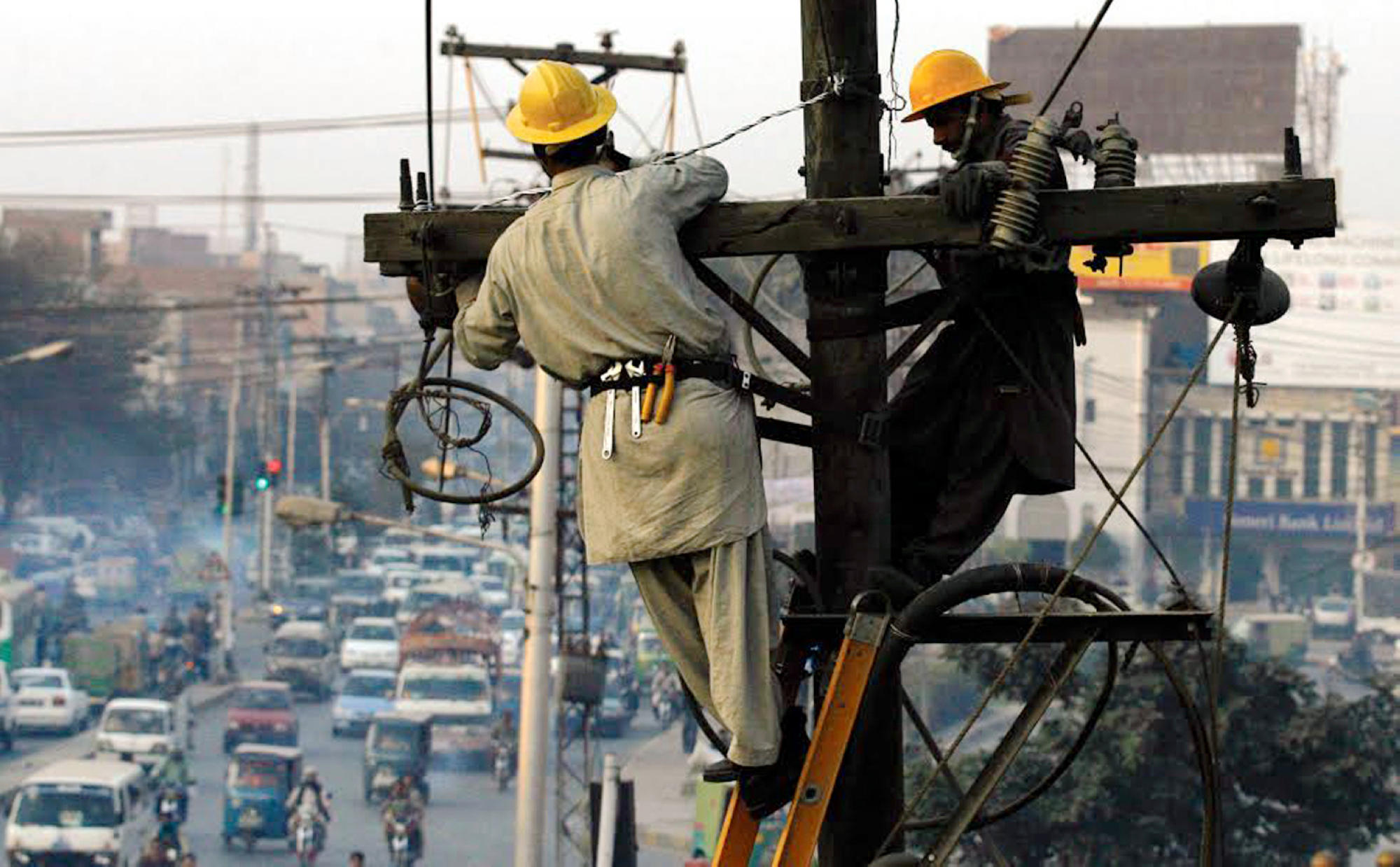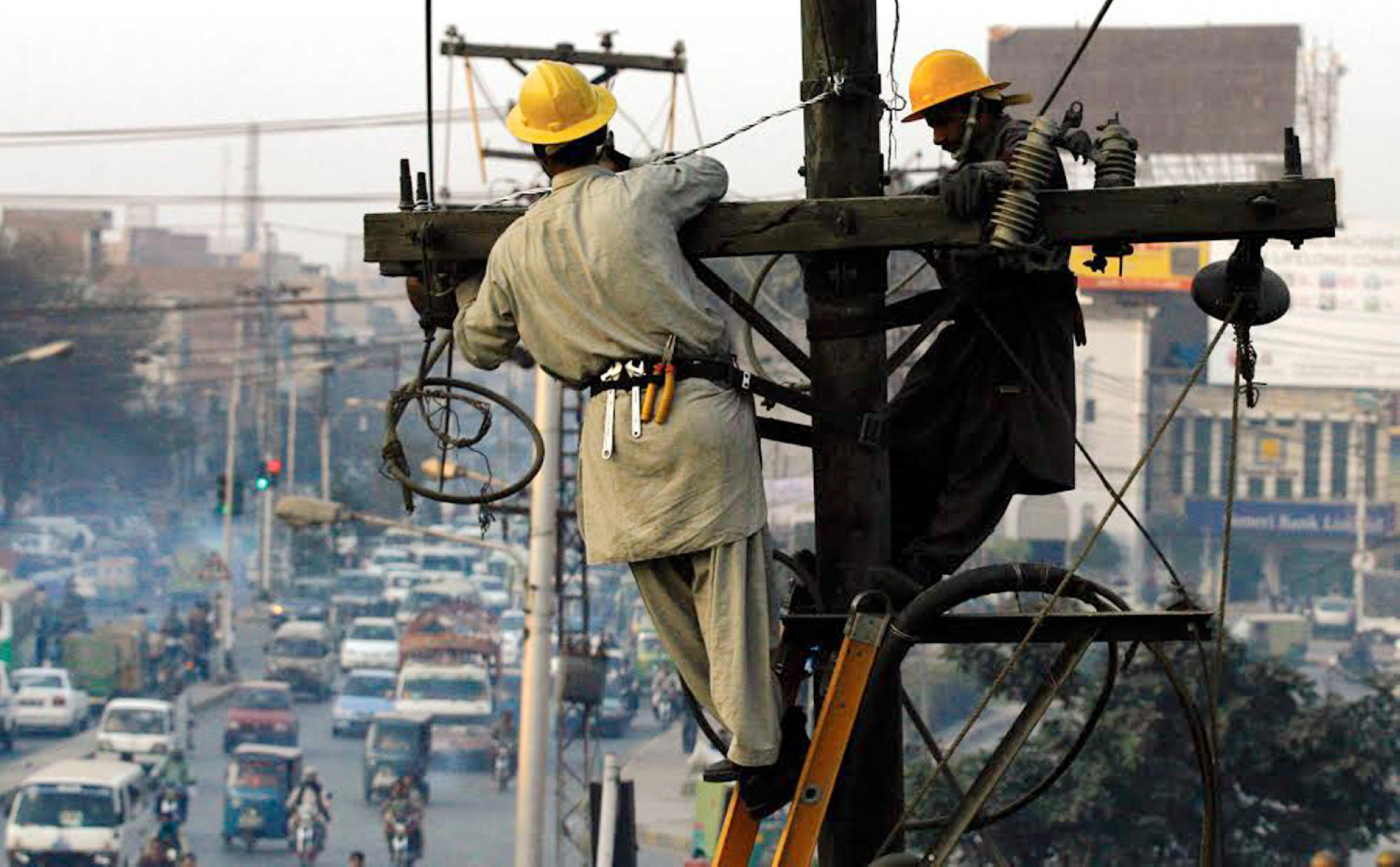Analysis: Pakistan pays heavy price for excess power generation capacity
Pakistan is embroiled in a fierce debate over whether it was poor management of the power sector and the wider economy that has burdened the country with overcapacity – even as power cuts persist
This 2013 photo shows Pakistani technicians fixing an electricity tower in Lahore. Today, the country is in the midst of a debate about the future of its power sector as it confronts huge electricity payments amidst persistent blackouts
 Khurram Husain
Khurram Husain
March 10, 2021
In 2017, Pakistan finally overcame its chronic power shortage and simultaneously broke its decades-long growing addiction to imported furnace oil as the main fuel for power generation. But the feat came at a steep price.
Today, the country is in the midst of a debate about the future of its power sector as it confronts huge electricity payments amidst persistent blackouts due to an inability to operate all its plants and handle the associated costs. Partially as a result of this, the so-called “circular debt” of the power sector has surged from PKR 315 billion (USD 2 billion) in 2015 to beyond PKR 2.2 trillion (USD 12.7 billion) today.
Soaring electricity bills
Pakistan’s dilemma is a surplus of power generation capacity – a problem it has avoided since the late 1990s. “We are producing much more than we need,” Tabish Gauhar, the prime minister’s special assistant on power, has been telling the media since January.
In his
public remarks, he points out that the country cannot afford the new electricity that has been in its system ever since a spate of Chinese-built power plants began to come online since 2017. Gauhar also attributes the bulk of the increased cost to “fixed capacity charges” that he says have “gone through the roof”.
By some estimates, the country has had to pay capacity charges of PKR 850 billion (USD 5.41 billion) a year in the last few years, a figure projected to rise beyond PKR 1.45 trillion (USD 9.2 billion) by 2023 – by when it will be larger than the country’s present peacetime defence budget.
Technically capacity charges are not a budgetary item (they are paid through power bills sent to consumers rather than out of the government’s own budget). The escalating cost of surplus power generation has meant a continuous rise in consumer power tariffs. This has fuelled inflation, eaten away at industrial competitiveness, and necessitated growing resort to government-funded subsidies on power tariffs to shield export-oriented industries from the full brunt of the tariff hikes.
33% of Pakistan’s energy came from hydropower in the first seven months of the 2021 fiscal year.
In Pakistan, the government is the sole buyer of power. Since reforms designed to allow greater room to market forces in the power sector have not advanced in the previous two decades, the bill for these capacity charges either has to be paid by consumers or shared by the government via subsidy payments.
According to Power Minister Omar Ayub, the government paid more than PKR 470 billion (USD 2.99 billion) in power subsidies last year, making it one of the largest heads in current expenditures that have to be curtailed sharply under the terms of the IMF programme that Pakistan is seeking to restart. Only two years ago this amount was closer to PKR 90 billion (USD 573 million).
With the projected growth of capacity payments against surplus power, in the years to come the subsidy bill will rise even more sharply, making it unaffordable for the government and putting it in the unenviable position of having to hike power tariffs even further. This will burden consumers more, fuelling inflation and pricing Pakistani exports out of global markets.
Partly in response to this, the government is trying to persuade the textile export industry to switch away from gas-fuelled captive power plants that they were encouraged to install since the power shortages began to bite after 2008. The government argues that large power consumers like the export industry need to return to the grid for their power requirements. The move has sparked intense pushback from industry, with the argument that grid power is too expensive for them.
In January this year, the government announced a 15% average increase in power tariffs across the board, arguing that the step was necessitated by “compulsory payments” that have come with the new power generation capacity installed in recent years. It also pointed out that the increase is less than a quarter of what was required to offset the cost spiral it is facing as more and more power plants come online.
A crisis foretold
To some extent this was anticipated, and hotly debated within the previous government. In November 2014, the governments of Pakistan and China signed an agreement “[f]ollowing market-based principles of openness, equality and mutual benefit to develop related energy projects” under which 14 projects were listed as “prioritised” and another seven as “actively promoted”.
In November 2014, the governments of China and Pakistan signed this agreement under which all the power sector investments have been made.

www.slideshare.net
In November 2014, the governments of China and Pakistan signed this agreement under which all the power sector investments have been made.
In 2016, as these projects were kicked off, Pakistan’s power generation capacity was just under 20,000 MW, of which almost two thirds was accounted for by hydel and furnace oil-based plants. Two LNG-based plants had just kicked in, adding 1,673 MW of generation to the system. But government projections at the time showed that by 2018, another 13,207 MW was going to be added to the system as the Chinese power plants reached commercial operations. Of this 6,900 MW or slightly more than half would be accounted for by plants running on imported coal and LNG. The next round of capacity expansion would run from 2019 until 2022, adding another 20,380 MW to the system, of which hydel was the largest share at 9,010 MW, followed by nuclear at 4,400 MW and then local coal at 3,300 MW as more power plants came online at the Thar coal fields in the south east of the country. By 2023, when all projects in the pipeline were scheduled to be complete, the country’s total power generation capacity would have more than doubled to reach 53,504 MW.
According to the projections made by the government at the time, Pakistan’s demand for power by June 2018 was projected at 25,961 MW, which assumed that the GDP growth rate would continue at around 6% (in fact growth crashed to near zero in 2018). Its total generation capacity at that point would be 30,938 MW, of which 25,590 MW would be available at any given time. The projections showed a surplus emerging in 2018 even with a growth rate of 6%.
Not only that, the share of power being generated from renewable sources (such as solar photovoltaic, wind and hydel) would have reached nearly 43% of total generation capacity, up from 37% in 2016. Coal-based generation was projected to touch 17% of the total, up from 0.3% in 2016.
With these new additions, Pakistan was on course to not only bridge its chronic shortfall in power generation capacity, but also reach a long sought goal of diversifying its fuel mix away from expensive furnace oil. Under the old power policies of the 1990s, Pakistan’s fuel mix had worsened to the point where almost 70% of all power generation used thermal sources such as furnace oil and gas. As the period of gas shortages began after 2005, reliance on furnace oil only increased, straining foreign exchange reserves and driving up the price of power.
Pakistan's energy generation mix
First 7 months of the 2021 fiscal year
Source: Arif Habib Ltd • *RLNG = Regasified Liquefied Natural Gas
The fuel mix for Pakistan’s power sector has changed profoundly after the Chinese funded power projects started coming online in 2017. Prior to this, the country relied overwhelmingly on furnace oil and gas to meet its power generation needs. In the first seven months of the current fiscal year, by contrast, 5% of its total power has been generated using furnace oil.
Under the new capacity expansion plan agreed with the Chinese, the share of furnace oil-based generation was projected to decline to 11% of the total by 2022, by which time all the projects were supposed to have commenced commercial operation.
But concerns began to mount within the government about the impact these capacity additions would have on the fiscal account, as well as the foreign exchange requirement under increased imports of LNG and coal.
The same projections, made in 2016 by the power division, showed capacity payments more than doubling by 2018.
Internal documents within the power division showed that capacity payments that stood at PKR 272 billion in 2015, or approximately 30% of total generation cost, would rise sharply to PKR 630.8 billion by 2018, or almost 50% of the total generation cost. That figure was hit in the year 2019 instead, and according to the power minister, is projected to rise to PKR 1.455 trillion by 2023.
The power sector regulator, Nepra, however, provides a more complex picture for the spiraling costs that are weighing on power generation. In its
latest annual report, for example, Nepra says cost of generation is increasing due to multiple factors. These included mismanagement by the distribution companies, non-availability of LNG for the more efficient, newer plants, excessive levies and surcharges on grid power to aid the government’s revenue effort and transmission constraints in some newer plants, among others.
Power interrupted
The Chinese capacity expansion may have helped overcome power generation shortfalls in Pakistan, but more chronic problems of a creaking transmission network, poor bill recovery track record as well as keeping emissions under check have remained in place.
Members of the previous government under whom these power plants were commissioned argue that their projections were based on continuing 6% to 7% growth rates in the economy. With the coming of the new government in 2018, the growth rate plunged to below 2%, and went negative in 2020 as Covid-19 lockdowns swept the country.
This year’s growth rate is projected to be 1.5% according to the IMF, or up to 2.5% as per the government’s projections. “You don’t factor in recessions when making power sector capacity expansion plans,” said a bureaucrat who worked under the previous government’s power team, speaking on condition of anonymity due to the heightened political sensitivities that have enveloped Pakistan’s energy conversation.
Today, Pakistan is embroiled in a fierce debate over whether it was poor planning or bad management of the power sector, and the wider economy, that has burdened the country with excess power generation capacity. What is harder to debate, however, is the mounting bill.
Pakistan is embroiled in a fierce debate over whether it was poor management of the power sector and the wider economy that has burdened the country with overcapacity – even as power cuts persist

www.thethirdpole.net















